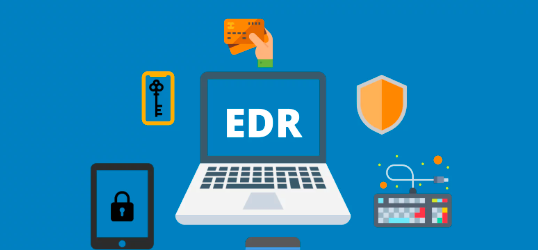Strengthening Cybersecurity with Endpoint Detection and Response (EDR) Technologies

Table of Contents
- What is EDR?
- Importance of EDR in Cybersecurity
- How EDR Works
- Features of Effective EDR Solutions
- Challenges in EDR Implementation
- Future of EDR Technologies
- Real-World Examples of EDR in Action
- Best Practices for Implementing EDR
What is EDR?
In the dynamic realm of digital security, staying a step ahead of potential threats involves utilizing potent strategies like endpoint detection and response (EDR). EDR encompasses technologies and techniques that fortify endpoints such as computers, servers, and mobile devices—against cyber threats. These points of contact are integral to organizational networks and are often prime targets for hackers seeking access to critical data or systems. The growing complexity of cyberattacks necessitates using EDR systems, which are essential for organizations. These systems offer a proactive strategy to identify and mitigate threats before their potential to inflict substantial damage.
EDR’s ability to offer a comprehensive look into endpoint activities, collecting real-time data that security teams can analyze for anomalies. Unlike traditional security measures that might react only after a breach, EDR tools are vigilant watchdogs. By continuously scanning for signs of illicit activities, these solutions give IT teams the insights to combat threats preemptively. Furthermore, EDR’s role extends beyond mere detection, encompassing analysis, investigation, and automated response to threats, thus ensuring a layered and robust defense mechanism against potential breaches.
Importance of EDR in Cybersecurity
The growing landscape of sophisticated cyber threats has made endpoint security more critical. EDR plays a vital role in modern cybersecurity frameworks as it focuses on safeguarding employees’ tools to access company networks. Statistics indicate a worrying surge in incidents targeting endpoint devices; implementing EDR systems is beneficial and essential. By constantly monitoring endpoint activities, EDR identifies potential security threats in their nascent stages, allowing organizations to respond rapidly and effectively.
Moreover, EDR solutions integrate seamlessly with other cybersecurity applications, providing a more holistic approach to network security. This synergy is fundamental in addressing the escalating volume and complexity of cyber assaults targeting endpoints. Therefore, companies incorporating EDR into their cybersecurity strategy often find themselves better equipped to fend off evolving threats, preserving their information assets’ integrity, availability, and confidentiality.
How EDR Works
The functionality of EDR revolves around continuous surveillance of endpoint devices and capturing critical data on user interactions and network activities. This data is subsequently analyzed through sophisticated algorithms and analytical methods to distinguish between typical and questionable behavior. When an anomaly occurs, EDR alerts cybersecurity teams and can initiate automated countermeasures to isolate and mitigate the threat. Including machine learning in EDR, strategies further enhances this process, allowing the technology to evolve and more adept at detecting intricate and novel attack patterns.
Features of Effective EDR Solutions
- Real-time Monitoring: An effective EDR solution relies on real-time monitoring, ensuring timely data collection and processing. This capability serves as the foundation for rapid threat recognition and response.
- Automated Response: Given the speed at which cyber threats can escalate, automation in response initiation is critical. EDR solutions capable of autonomous threat containment can significantly reduce the time windows within which attacks can evolve.
- Threat Intelligence Integration: By embedding external threat intelligence feeds, EDR solutions gain enhanced context and depth in their detection capabilities, thus allowing them to preemptively identify and thwart incursions that align with known threat patterns.
These attributes optimize EDR implementations’ efficacy and contribute to more dynamic and robust cybersecurity postures. The utility of advanced EDR features in defending against sophisticated threats is well-documented in resources like TechTarget, which offer insight into how these technologies are reshaping the cybersecurity landscape.
Challenges in EDR Implementation
While EDR systems offer numerous benefits, organizations face several hurdles during implementation. One of the main difficulties is the smooth integration of EDR tools with the current IT infrastructure, ensuring no disruptions in operations. Many businesses need help managing the influx of data generated by EDR solutions, which can impede performance if handled correctly. Organizations must balance its comprehensive coverage and practicality, ensuring that EDR tools do not overload cybersecurity staff with alerts, leading to fatigue and reduced effectiveness.
Future of EDR Technologies
The future of Endpoint Detection and Response (EDR) technologies is bright, especially with the ongoing evolution of the cyber threat landscape and the incorporation of artificial intelligence (AI) and machine learning. These advancements could significantly enhance threat detection accuracy and response times. Future Endpoint Detection and Response (EDR) systems are expected to utilize artificial intelligence to detect emerging threats before their formal identification, thereby enhancing the efficiency of the security framework. As organizations increasingly prioritize cybersecurity within their operational strategies, EDR technologies will likely evolve into more adaptive, intuitive, and practical tools for countering undetected threats.
Real-World Examples of EDR in Action
The practical benefits of implementing EDR solutions are discernible from numerous success stories across diverse industries. For instance, several healthcare organizations have adopted EDR to safeguard sensitive patient data against ransomware attacks, which have been alarmingly prevalent. In one instance, prompt threat detection and isolation through EDR prevented a potentially devastating breach, illustrating the life-changing potential of these solutions. Such examples highlight EDR technologies’ indispensable role in various sectors that rely heavily on the integrity and security of their data and operations.
Best Practices for Implementing EDR
- Consistent Updates and Patch Management: Regularly updating and patching endpoint devices reduce the risk of vulnerabilities that cyber attackers could exploit.
- Employee Training and Awareness: Equipping employees with secure practices and threat awareness can minimize risky behaviors compromising security.
- Integration with Existing Systems: EDR solutions should be effectively combined with other cybersecurity measures to establish a multi-layered defense system and enhance protection capabilities.
Adopting these best practices facilitates more efficient deployment of EDR and enhances its protective advantages, strengthening the organization’s defense against the complex cyber threats prevalent in our time.







